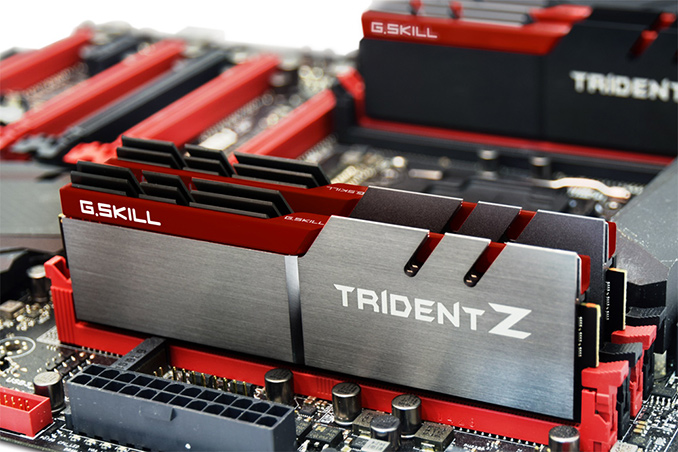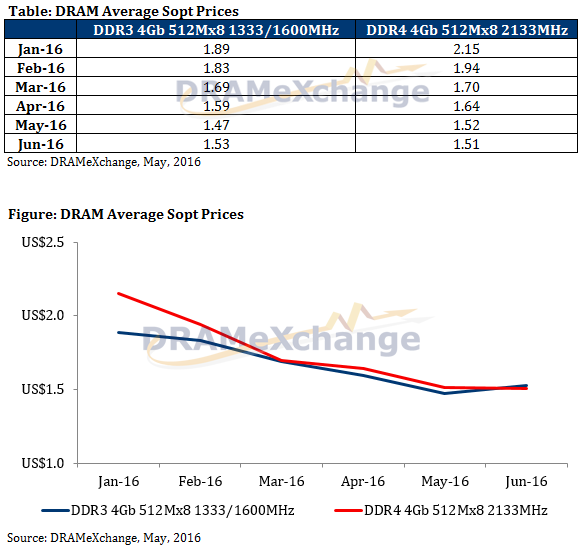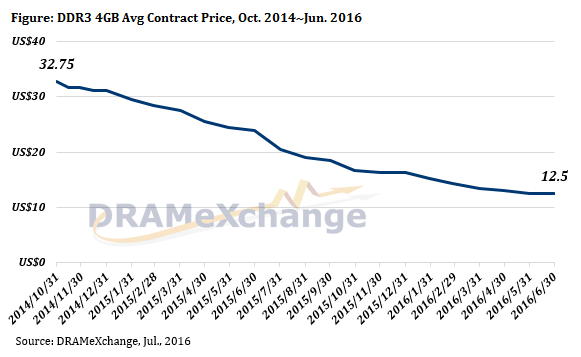Price Check Q3 2016: DRAM Prices Down Over 20% Since Early 2016
by Anton Shilov on July 25, 2016 12:01 AM EST
Slow sales in the first half of 2016 have negatively affected suppliers of virtually all of PCs, tablets and smartphone components. Producers of DRAM typically suffer more than others when it comes to pricing, since computer memory is considered a commodity and its quotes mostly depend on supply and demand rather than on technology advantages. Since early 2016, prices of DDR3 and DDR4 chips have declined by over 20%, according to DRAMeXchange (a division of TrendForce that tracks DRAM market). Despite the fact that it is slightly costlier to produce DDR4 memory because of slightly larger die sizes, at times the physical DDR4 modules can actually be cheaper than DDR3 ones. Since producers like Micron, Samsung and SK Hynix are not happy with the current situation on the market, observers have reported that the big three intend to implement a plan to control supply.
DDR3 Vs. DDR4: Crossover Is Nearing
The average spot price of one 4 Gb DDR4-2133 memory chip was $1.751 in late-July, according to DRAMeXchange (most information in this piece is from this source unless otherwise stated). For comparison, in Feb '16 the equivalent chip was $1.814. Going back further, in Dec '15 they were $2.221, and in late June '15 up at $3.618.
As it turns out, a 4 Gb DDR4-2133 memory IC (integrated circuit) is nearly 50% cheaper in the last 13 months and around 22% cheaper since the start of the year. The average contract price of a DDR4-2133 DRAM chip was $1.31 in the second half of June, down from $1.63 in the second half of January. Meanwhile, in the recent months DRAMeXchange has begun to track spot prices of 8 Gb DDR4-2133 chips. Right now one chip costs $3.633 on average, down from $4.688 in mid-April.
Spot prices of DDR3 memory are dropping fast as well. A 4 Gb DDR3-1600 memory IC costs $1.675 in Taiwan, down from $1.878 in December and $2.658 in late June '15. In about a year, a 4 Gb DDR3 chip is 37% cheaper, mainly due to slow demand for electronics. 8 Gb DDR3-1600 memory chips are considerably more expensive than DDR4 chips of the same capacity, also tied to demand. At the time of writing (7/22/16), one of such chips cost $4.96.
Right now, the spot price of 4 Gb DDR4 memory chips is a little higher than the price of 4 Gb DDR3 DRAM ICs. The gap is only around three cents, but still volatile and we would not make any definitive conclusions at this point as to the reasons why. Back in June, DDR4 chips were cheaper than DDR3 ICs (in fact, they were slightly cheaper than DDR3 chips throughout the whole month) and we observed a similar situation in March, but eventually DDR4 regained its price advantage over its predecessor because the demand for such type of DRAM has grown as Intel is ramping up its DDR4-supporting platforms. It is unclear whether leading DRAM IC producers are now deliberately making more DDR4 chips, such that the supply of such memory exceeds demand. If this is the case, then we are observing the inevitable DDR3/DDR4 price crossover point. If this is not, then, DDR4 will regain its price premium over DDR3 in the coming weeks because more systems are adopting the newer type of memory.
It should be obvious that prices of DRAM ICs directly affect the prices of actual memory modules used by PC makers. In the second half of April '16, one 4 GB DDR4-2133 SO-DIMM was priced at $13 on contract basis, down from $15.50 in the second half of January. Meanwhile, the contract price of one 4 GB DDR3-1600 SO-DIMM dropped to $12.50 (down from $15.25 in January, 2016).
It is noteworthy that starting from early June prices of DDR3 and DDR4 memory have been slowly increasing. Market observers believe that this is happening because DRAM makers are switching to production of server-class and LPDDR memory, reducing supply of commodity DRAMs ahead of the back-to-school season. Nonetheless, it should be observed that in the last couple of years nothing could stop memory prices from coming down. At various times it looked like they had stabilized or even increased, but in the end, they just continued their slump.
Now, let’s take a look what is going on in the U.S. retail.












37 Comments
View All Comments
Ratman6161 - Monday, July 25, 2016 - link
Ummm. I think you may have your decimal points in the wrong position? i.e. $1.751 should be $17.51? Looking on NewEgg I don't see a single 4 GB modual for a dollar seventy five :)bananaforscale - Monday, July 25, 2016 - link
Those are chip prices, not module prices, and it's 4 Gb, not GB. Put 8 of those on a DIMM and you're in the ballpark.Ratman6161 - Monday, July 25, 2016 - link
Ahhh. My mistake. I generally don't bother thinking about the cost of components within the components - just the actual module I'm buying.:)andychow - Monday, July 25, 2016 - link
Wouldn't that be defined as illegal collusion?
FunBunny2 - Monday, July 25, 2016 - link
-- Wouldn't that be defined as illegal collusion?this is the USofA. everything in law has to be "business friendly".
DanNeely - Monday, July 25, 2016 - link
Only if they meet privately and do it in secret. Public statements on the line of "a pricewar from flooding the market and driving sale costs below production costs would only screw everyone; we're not going to start one" are fine.poohbear - Monday, July 25, 2016 - link
This is a cyclical industry, and DRAM prices have bottomed out. They've already started the upwards trend in pricing, next year they should be considerably more expensive, so buy now if you plan on upgrading within the next year before prices go up!